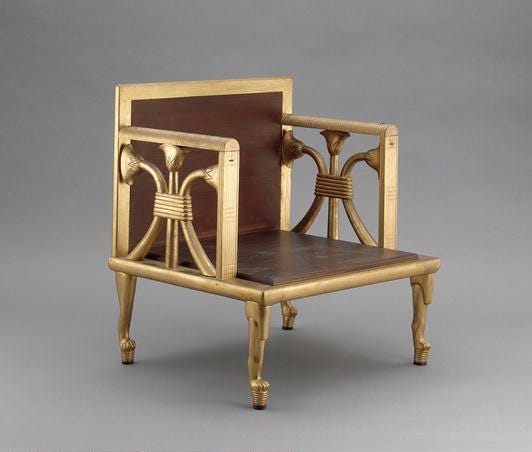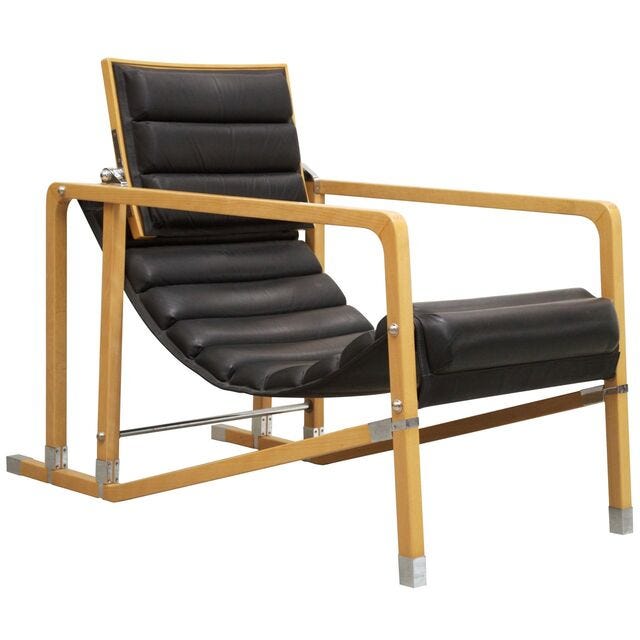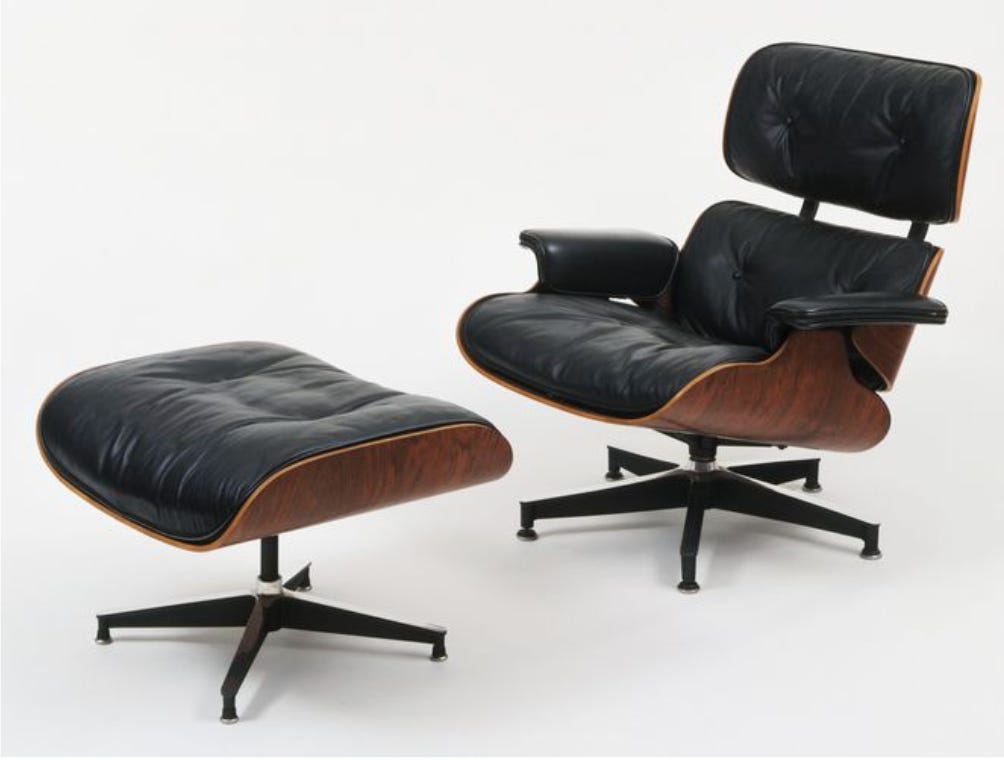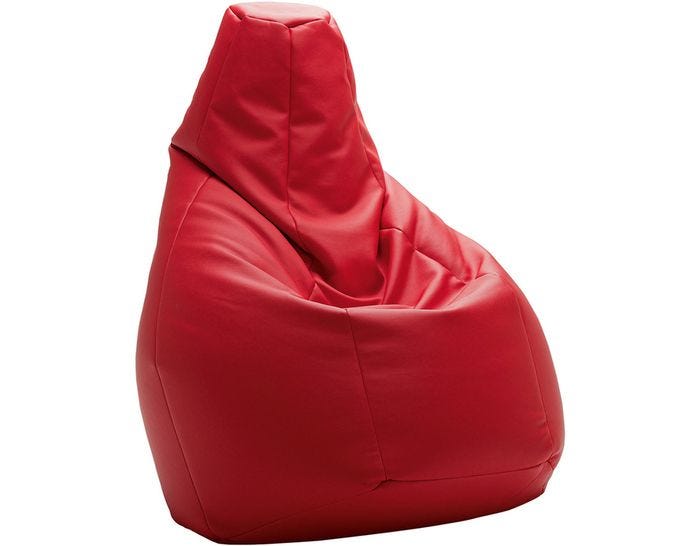Yes, you read that correctly. Today I am going to spend close to 1000 words discussing chairs. Why? Because so much of the reason I love design is connected to the practice of careful looking – of taking something mundane and dissecting its particularities. There is something thrilling about pulling apart the threads that have held something together so solidly in your mind for years. There is excitement in realizing that the things that make up our every day have stories and histories as complex as ourselves.
And so – chairs.
As I write this, I am sitting on a short-backed blue velvet chair in my London living room, facing the bay windows that look out onto the busy street below. For all of us who work desk jobs, chairs structure almost every hour of our waking day (literally and figuratively). And in our current climate of standing desks and miniature under-desk treadmills, chairs have developed the reputation of being harbingers of heart disease and other maladies. Perhaps an unfair assessment of an object which, for millennia, has served as a unique totem of both fashion and functionality. In discussing his book on the 5,000-year history of the chair, architect Witold Rybczynski notes the particular stasis of the chair: “If you’re sitting in a Windsor chair, that’s the same chair, for all practical purposes, that George Washington and Benjamin Franklin sat in. Nothing else from that time, other than the [U.S.] Constitution, has survived [in such usable form].” The choices we make, then, about the ways in which we choose to sit say more about us than we might perhaps imagine.
The first chair identified in the historical record is not an actual chair, but rather a sculpture of one which comes from the island of Keros in the Cyclades and dates to 2800–2700 BCE. Here, a male figure, now housed in the Met, sits on a high-backed chair while playing a stringed instrument. This figurine is one of a handful of similar Early Cycladic sculptures which form some of the earliest known representations of musicians. Comparatively, the award for the earliest known actual chair goes to the Egyptians who crafted a wide variety of chairs from stools to benches to chairs to thrones. Thanks to the desert conditions of the region, examples have survived which provide evidence for their use as early as the 2nd Dynasty (c. 2890–c. 2686 BCE). The armchair of Hetepheres I, the mother of Khufu, is a particularly stunning example of Egyptian craftwork dating to c. 2589–2566 BCE.

Ancient Nineveh favoured chairs without backs whose legs tapered into elegantly carved lions’ claws or bulls’ hoofs. Ancient Greece, however, brought backs back with their klismos chair, the earliest examples of which date to the fifth century BCE. Featuring elegantly curved legs and a carved backrest, the klismos appears surprisingly modern at first glance. With its clean lines and graceful contours, the Greeks’ klismos is not only modern in look but also in function. In ancient Greek art, klismos chairs are available to everyone. Women, men, gods, the wealthy, the poor, musicians, and workers all appear in various forms seated on klismoi — “a democratic chair”, according to Rybczynski. Romans selectively adopted the klismos but instead preferred long dining couches called klinai (you know the ones). The allure of the klismos is also its mystery; the design appeared to have emerged independently without obvious precedents only to disappear for a millennia after the fall of the Roman Empire.


The design then reemerged as part of the Greek Revival movement in the late 18th and early 19th centuries where it began to appear in historical paintings and prints before being used as a model for actual furniture designs. This revival evolved from the stratified hierarchy of Medieval seating where furniture became one marker among many of wealth and prestige. Chairs – or thrones — with arms and backs or ornate decoration often coincided with sites of religious or political importance. In other corners of the world, chairs emerged in China in the twelfth century for reasons that are still unclear while in Mexico the woven icpalli chair became a feature of Aztec culture in the early fourteenth century. The tension between hierarchy and democracy has not only been a feature of chairs over the millennia, but it is also a common question of design more broadly.


As chairs lost their connotation of privilege during the Renaissance, they quickly began to reflect contemporary fashions. Size, shape, material, and decoration all became opportunities to display design trends and personal taste; timber frames were replaced with papier-maché and then eventually with more modern materials such as metal and moulded plastic. One of the most iconic chairs that marked the transition from traditional upholstered timber chairs is Michael Thonet’s bentwood No. 14 chair or bistro chair. Introduced in 1859, the chair was made of six pieces of steam-bent wood, ten screws, and two nuts, making it both affordable and easy to assemble – Ikea but make it art nouveau. The chair became one of the best-selling chairs ever made with some 50 million No. 14s sold between 1858 and 1930. The piece ushered in a transformation of chair design which prioritized simplicity and practicality over luxury and ornament.
Inspired by Thonet’s work with steam-bent wood, the Hungarian-born modernist architect Marcel Breuer designed both his Wassily and B32/Cesca using bent non-reinforced tubular steel inspired by bicycle handles. A prominent member of the Bauhaus, Breuer approached furniture design with the same sculptural eye that he did in his architectural projects (see: the Met Breuer building in NYC). While the Wassily chair continues to dominate Instagram architecture pages today, it was the Cesna chair that was truly revolutionary at the time, providing a comfortable seat that seemed to float on only two legs.

From Breuer emerged a pantheon of modernist chairs, many of which began to view comfort as an equally essential component of good design. Eileen Gray’s 1927 Transat was inspired by the deck chairs of steamships from which it derives its name, an abbreviation for “transatlantic”. The chair’s wooden frame is characterised by complicated joinery and chrome brackets while the sling seat sits low to the ground inviting one to stay and lounge awhile. Ray and Charles Eames’ Lounge & Ottoman similarly evokes all the pleasures of idleness. You can see the evolution of Thonet’s earlier bentwood designs with added elements of luxury. Leather and padding are complimented by swivels and tilts which now ‘[epitomize] sexy midcentury executive style, masculinity, and comfort.’
In another study in leather, Ludwig Mies van der Rohe and Lilly Reich’s Barcelona chair presented an exception to the democratic principles of the Bauhaus. It was designed for the Spanish Royalty to oversee the opening ceremonies of the International Exposition of 1929 hosted in Barcelona, Spain. Originally designed with bolted metal pieces, the chair was redesigned in 1950 using stainless steel allowing the frame to be formed of a single piece of metal. Simple materiality, understated elegance, and perfect proportions harken back to the lines of the Greek klismos which are also found in van der Rohe’s disciplined architecture.

I could continue of course –but I won’t. Eero Saarinen’s Tulip, Le Corbusier’s Grand Confort, Arne Jacobsen’s Egg, the Eames brothers’ LCW, Emeco’s Navy, Verner Panton’s Panton, Philippe Starck Louis’s Ghost, and Xavier Pauchard’s Chaise A are all worthy of mention in this era of modernist revolution. What has stayed with me in thinking and reading about something as simple as chairs over this past week is not only the care but also the joy with which so many of these examples were made.
Frank Gehry’s Wiggle Side Chair, Gerrit Rietveld’s Zig-Zag Chair, and PiPiero Gatti, Cesare Paolini, and Franco Teodoro's original beanbag (or Sacco) chair all capture the whimsy and creativity which have flourished in the design of the past century. No longer limited by practical structural constraints, these examples present compelling cases for what is possible within the confines of a simple objective: make something to sit on.
We spend a shockingly large portion of our lives seated. A fact which perhaps should encourage us to take the objects we sit upon more seriously. Chairs, in all their many forms, have reflected and refracted the cultures in which they were found. Design itself was often a revolutionary tool of democratization or stratification, a quality which has remained vital to the chair’s evolution until today. Even something as simple as the Monobloc plastic chair or the Aeron office chair were once revolutionary in their stackability (for the former) and ergonometic comfort (for the latter).
Revolution and design go hand-in-hand, asking us to reconsider the environment of our everyday. So I challenge you to pick something boring, something quotidian, something unconditionally mundane, and revolutionize it. Trace its history. Pick it apart. Find the radical design that has conspired to create the object you see now. This practice of questioning and careful looking can be applied to objects far beyond the simple chair – but is an activity perhaps best undertaken while seated.
With love : Avery













